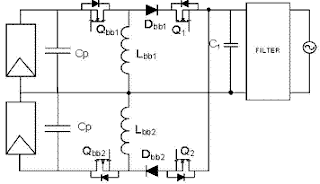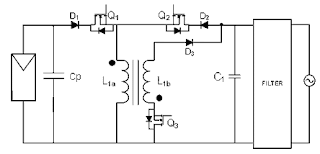ABSTRACT:
This paper presents a comprehensive review of
step-up single phase non isolated inverters suitable for ac-module
applications. In order to compare the most feasible solutions of the reviewed
topologies, a benchmark is set. This benchmark is based on a typical ac-module application
considering the requirements for the solar panels and the grid. The selected
solutions are designed and simulated complying with the benchmark obtaining
passive and semiconductor components ratings in order to perform a comparison
in terms of size and cost. A discussion of the analyzed topologies regarding the
obtained ratings as well as ground currents is presented. Recommendations for
topological solutions complying with the application benchmark are provided.
KEYWORDS:
1. AC-module
2. Photovoltaic(PV)
3. Step-up
Inverter
4. Transformerless
SOFTWARE: MATLAB/SIMULINK
BLOCK DIAGRAM:
Fig.1 Block diagram of a two stage topology
for an ac module
STEP-UP TRANSFORMERLESS INVERTERS:
Fig
2 Boost converter and full bridge inverter
Fig
3 Time sharing boost converter with full bridge inverter
Fig
4 Parallel resonant soft switched boost converter and full bridge inverter
Fig
5 Parallel input series-output bipolar dc output converter and full bridge
inverter
Fig
6 Boost converter and half bridge inverter
Fig
7 Boost converter and neutral point clamped inverter
Fig
8 Series combined boost and buck boost and half bridge inverter
Fig 9 Center-tapped coupled inductor converter
with bipolar output and half bridge inverter
Fig
10 Single inductor bipolar output buck-boost converter and half bridge inverter
Fig 11 Boost + FB integrated and dual grounded
Fig
12 Block diagram of a pseudo-dc-link topology for an ac module
Fig
13 Buck-boost DCM converter and unfolding stage
Fig
14 Noninverting buck-boost DCM converter and unfolding stage
Fig
15 Switched inductor buck boost DCM converter and unfolding stage
Fig
16 Boost buck time sharing converter and unfolding stage
Fig
17 Block diagram of a single stage topology for an ac module
Fig
18 Universal single stage grid connected inverter
Fig
19 Integrated boost converter
Fig
20 Differential boost converter
Fig
21 Boost inverter with improved zero crossing.
Fig
22 Integrated Buck boost inverter
Fig
23 Buck Boost inverter with extended input voltage range
Fig
24 Differential buck boost inverter
Fig
25 Two sourced anti parallel buck boost inverter
Fig
26 Single stage full bridge buck boost inverter
Fig
27 Buck boost based single stage inverter
Fig
28 Switched inductor buck boost based single stage inverter
Fig
29 Single inductor buck boost based inverter
Fig
30 Doubly grounded single inductor buck boost based inverter
Fig
31 Single inductor buck boost based
inverter with dual ground
Fig
32 Three switch buck boost inverter
Fig
33 Coupled inductor buck boost inverter
Fig
34 Impedance-admittance conversion theory based inverter
Fig
35 Single phase Z source inverter
Fig
36 Semi quasi Z source inverter with continuous voltage gain
CONCLUSION:
In this paper, a comprehensive review of single
phase non isolated inverters for ac module applications is presented. Both the
grid connection and the solar panel requirements are analyzed emphasizing the
leakage current regulation as it is a main concern in non isolated PV grid
connected inverters. In order to compare the most suitable solutions of the
reviewed topologies under the same specifications, a benchmark of a typical ac
module application is set. These solutions have been designed and simulated, obtaining
ratings for the passive and the semiconductor components. These ratings are
used for the topology comparison in terms of size and cost. Furthermore,
detailed simulations of representative topologies have been performed using
semiconductor and inductor models to estimate the efficiency of the reviewed
solutions. As a result of the comparison, the required voltage boost necessary
for the connection to the European grid is difficult to achieve with
transformerless topologies, but it is adequate for U.S. requirements. Two stage
topologies, including the solution with dual grounding capability that
theoretically avoids the ground leakage currents, are the preferred option for
the set benchmark in which switching frequency for the dc-dc stage is set twice
than for the dc-ac one. The two stage combination of a step-up dc-dc converter
and a step-up inverter should be considered. In addition, the analyzed
pseudo-dc-link approaches are an alternative solution in terms of size and cost.
Furthermore, ground currents are expected to be low in these solutions because
of the line frequency interface and weighted efficiency is the highest due to
the flat behavior of the efficiency with the output power. The analyzed single
stage topologies have higher cost than the other analyzed solutions and control
is expected to be more complex to avoid dc current injection. In addition, DCM
operation mode allows smaller solutions, including a solution with dual ground
capability, but efficiency is lower due to the high RMS currents.



































